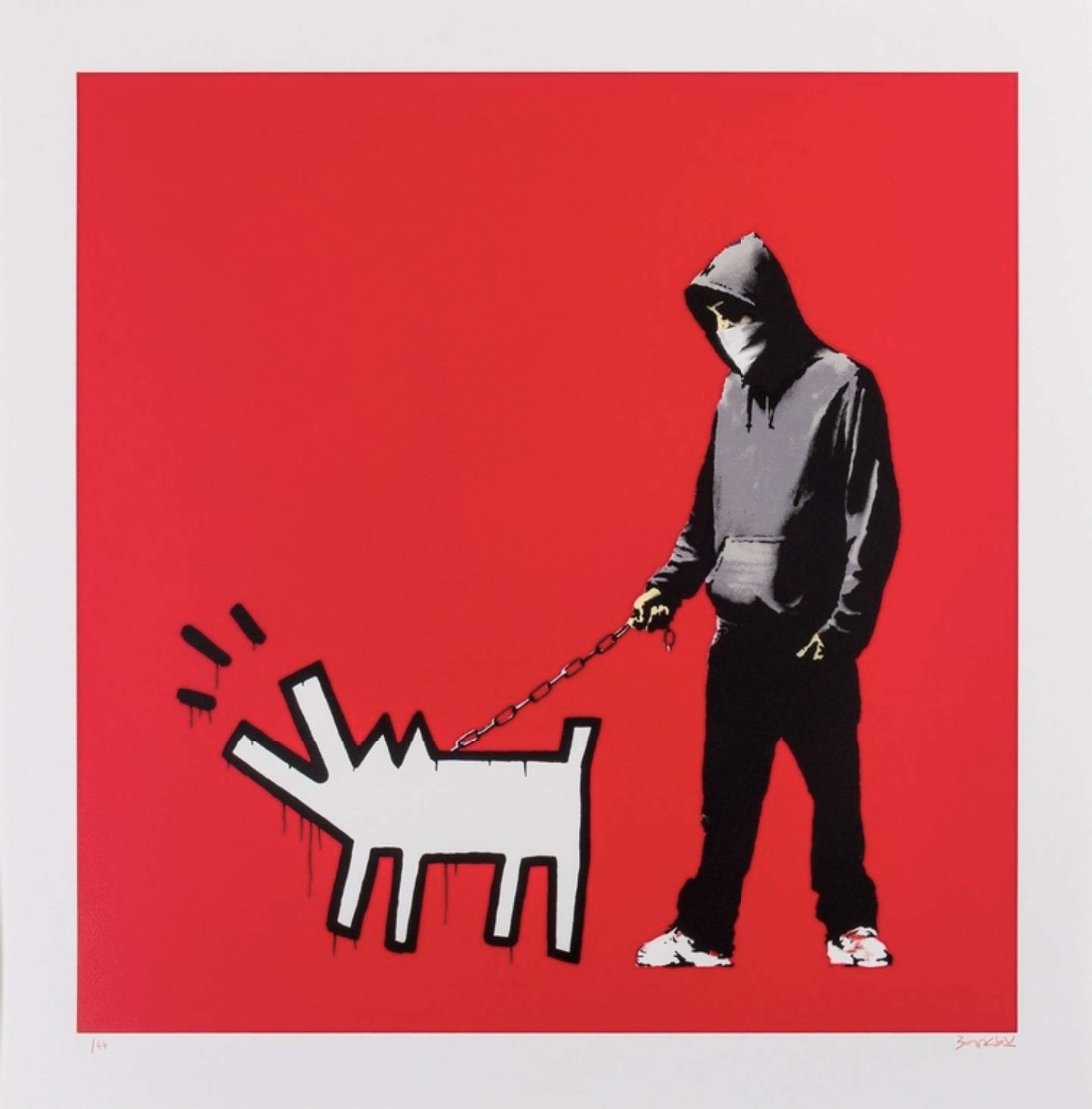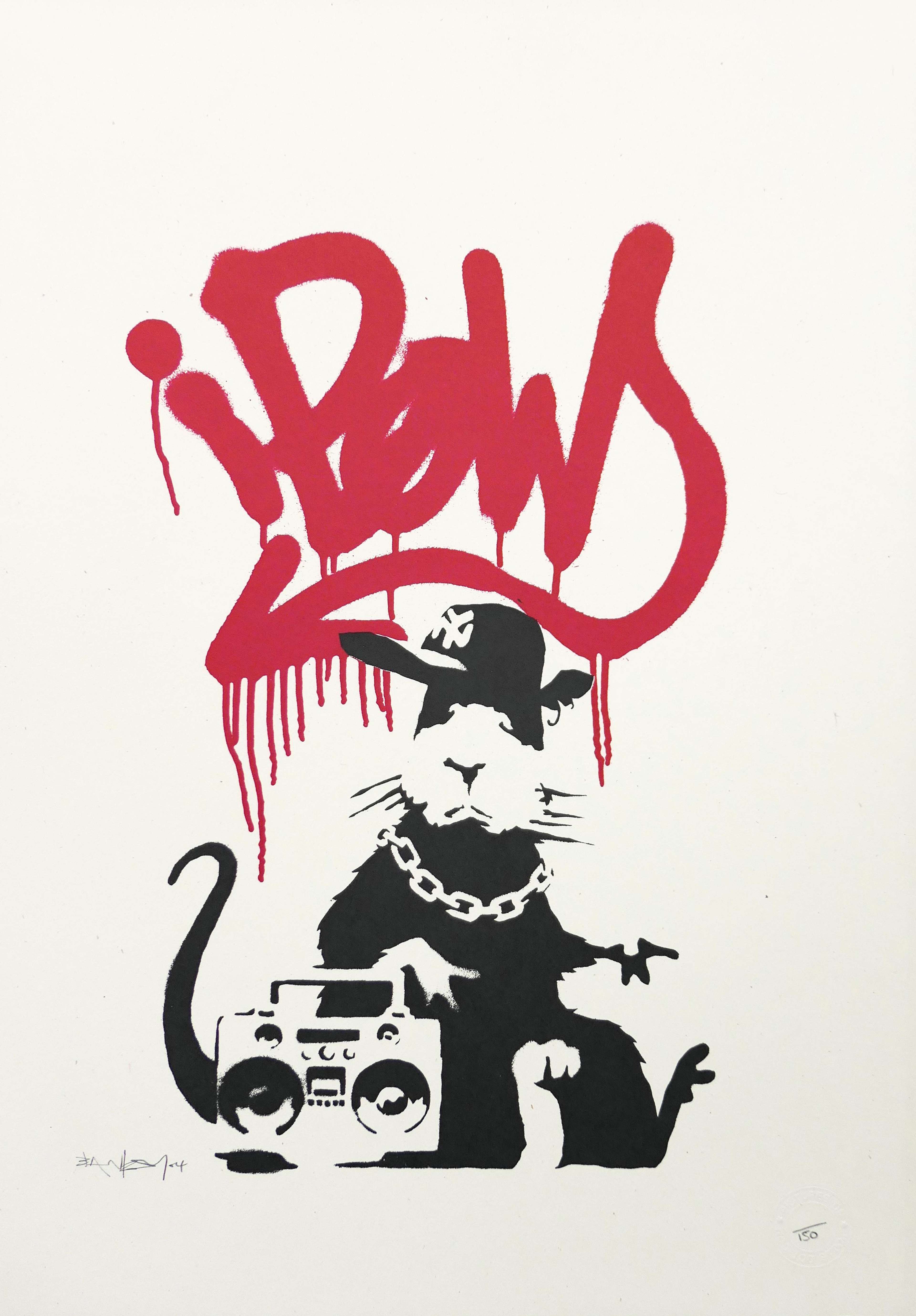Here Today, Gone Tomorrow: The Ephemeral Art of Banksy
 Love Is In The Air (Flower Thrower) © Banksy 2003
Love Is In The Air (Flower Thrower) © Banksy 2003
Banksy
269 works
Banksy, the anonymous British street artist, is one of the most enigmatic and influential figures in the contemporary art world. His satirical and politically charged artworks, often created in public spaces, have captured the imagination of millions around the world. From his iconic stencil art to his controversial installations, Banksy's unique style has earned him a global reputation as a cultural iconoclast.
Yet, the very nature of his work has also made it ephemeral, subject to vandalism or removal by authorities. As a result, Banksy's artworks have become highly sought-after, commanding exorbitant prices at art auctions and galleries.
Banksy's Identity: The Great Mystery
Known for his politically charged, and satirical art, Banksy is a big name - with a huge amount of mystery behind it. The artist has never revealed his real name or face and works under the cover of darkness to create his iconic artworks. Banksy's style is characterised by stencilling, which allows him to create intricate designs quickly and efficiently.
Banksy first gained attention in the early 2000s for his unique style and provocative statements on issues such as capitalism, war, and consumerism. His work has appeared on streets, buildings, and even in galleries around the world, attracting the attention of art enthusiasts and collectors alike. Banksy's impact on the art world cannot be overstated, as he has challenged traditional notions of art and the role of artists in society.
Despite his global acclaim, Banksy's public artworks are often ephemeral, subject to damage, vandalism, or removal by authorities. This has created challenges for preserving his works and has contributed to the high demand for his art. The scarcity of his works has also driven up their value, making them a popular investment choice for collectors and investors.
The Rise of Banksy's Street Art
Banksy's rise to fame began in the early 2000s, when his graffiti began appearing on the streets of Bristol, England. His street art gained popularity due to its unique style and political themes, which resonated with people around the world. Banksy's ability to convey complex messages through simple designs and powerful imagery quickly captured the attention of art lovers and critics alike.
As Banksy's reputation grew, so did his ambitions. He began taking on larger projects, including creating entire installations in public spaces. With his most iconic works including the Girl with Balloon mural, which has been replicated around the world, and the Dismaland theme park, a dark satire of Disney's theme parks.
Despite his success, Banksy has maintained his anonymity, which has only added to his allure. His mysterious persona and unconventional approach to art have challenged traditional ideas about the role of artists and the value of art.
The Ephemeral Nature of Banksy's Art
One of the defining features of Banksy's artwork is its ephemeral nature. The artist himself has stated that his artworks are not intended to last forever, but rather to spark conversation and prompt reflection on social and political issues. And despite the temporary nature of Banksy's art, his works have become highly sought after by collectors and investors, driving up their value. This has created challenges for preserving his works, as many of them are located in public spaces and cannot be moved or protected.
To combat this issue, some art collectors have taken to purchasing buildings or walls where Banksy's works are located, in order to preserve them. Others have attempted to remove Banksy's works from public spaces and place them in galleries or private collections. However, the removal of Banksy's street art from public spaces has been met with controversy as many argue that it goes against the artist's original intention of creating art for the public to enjoy and engage with.
Banksy’s recent animal-themed street works in London 2024 highlight the complexities of high-value street art. These animal murals, scattered across different parts of London, were quickly embraced by the public, yet their impermanence was highlighted as some pieces were defaced or stolen soon after their creation. The lone wolf, spray-painted on a satellite dish in Peckham, was stolen mere hours after its discovery, reflecting how quickly Banksy’s public art can be lost or altered. The temporary and fragile state of Banksy’s art highlights his intent to provoke immediate reflection, but the conversations encouraged by his art are far from fleeting. While the artworks themselves may not endure, the debates and discussions they inspire around social and political issues often persist long after the murals have disappeared.
The Challenges of Preserving Banksy's Public Artworks
Banksy's public artworks are a distinctive feature of his artistic portfolio. However, their ephemeral nature presents significant challenges to preserving them for posterity. Banksy's works, which are often displayed on public walls and buildings, are subject to vandalism, theft, and the elements, which can cause them to deteriorate rapidly. Furthermore, the unauthorised nature of many of Banksy's works means that they may be removed or painted over by property owners who do not appreciate their artistic value. This makes it difficult to preserve these works, which are often regarded as cultural treasures by art collectors and enthusiasts alike.
Despite these challenges, efforts have been made to preserve Banksy's public artworks. Some of his works have been protected with plexiglass or removed from their original locations and installed in galleries or museums. However, these efforts have been met with mixed reactions from Banksy and his fans, who argue that the artworks lose their authenticity when removed from their original place of creation.
The challenge of preserving Banksy's public artworks raises important questions about the nature of art and its relationship to public space. It also highlights the need for innovative preservation strategies that balance the desire to protect these works with the artist's original intent and the public's right to access them.
Demolished Banksy Artworks
Banksy's public artworks are known for their unique and thought-provoking messages, but on top of this - their format and tangible nature has been experimented with too. And in this experimentation, many of them have been both intentionally and accidentally destroyed over the years.
Flower Girl
One of Banksy's most iconic works, Flower Girl, depicted a young girl releasing a bunch of balloons. The artwork was stencilled onto a Hollywood gas station wall back in 2008 after the owner gave permission to an LA artist known as Mr Brainwash for his unidentified friend to create a mural. Once the mural had materialised, the gas station owner checked the CCTV footage only to notice that at the time of the works creation - the tapes went black.
The mural was then later broken out of the wall and auctioned off in 2013 for $209,000.
No Ball Games
This artwork, which showed two young boys playing catch over a No Ball Games sign, was painted on a wall in Tottenham, London. The wall was later demolished to make way for new construction, yet the mural was removed and divided into thirds. The parts were then sold for the benefit of disadvantaged children.
One Nation Under CCTV
This mural, which depicted a CCTV camera in the shape of a heart, was painted on a wall in London's Soho neighbourhood. The building was demolished in 2008, and the artwork was lost due to the Westminster City Council claiming that it was an unlicensed commercial.
Kissing Coppers
Kissing Coppers, which showed two male police officers kissing, was painted on the side of a pub in Brighton, UK. During its residency on the wall, it received huge amounts of damage due to repeated vandalism. Because of this, the pub home of the piece removed the piece and transferred it to canvas, however the owner ultimately decided to sell it on - making $575,000 at auction.
The Mild Mild West
The Mild Mild West piece depicted a teddy bear throwing a Molotov cocktail, and was painted on a wall in Bristol, UK. Though the piece was greatly loved by the community and symbolised the heritage of the local area, it was vandalised with red paint by an anti-vandalism organisation but was quickly repaired.
Banksy's Art Continues to Captivate the World
Banksy's street art has become a cultural phenomenon, sparking conversations about everything from politics and consumerism to identity and art itself. Despite the fleeting nature of his public works, Banksy's art continues to captivate the world, no better demonstrated than his grand retrospective: CUT & RUN. His pieces have become highly sought after by collectors and investors, with some of his works selling for millions of dollars at auction. His ability to blend street art with social commentary has made him a household name in the art world, and his influence can be seen in the work of countless artists.










